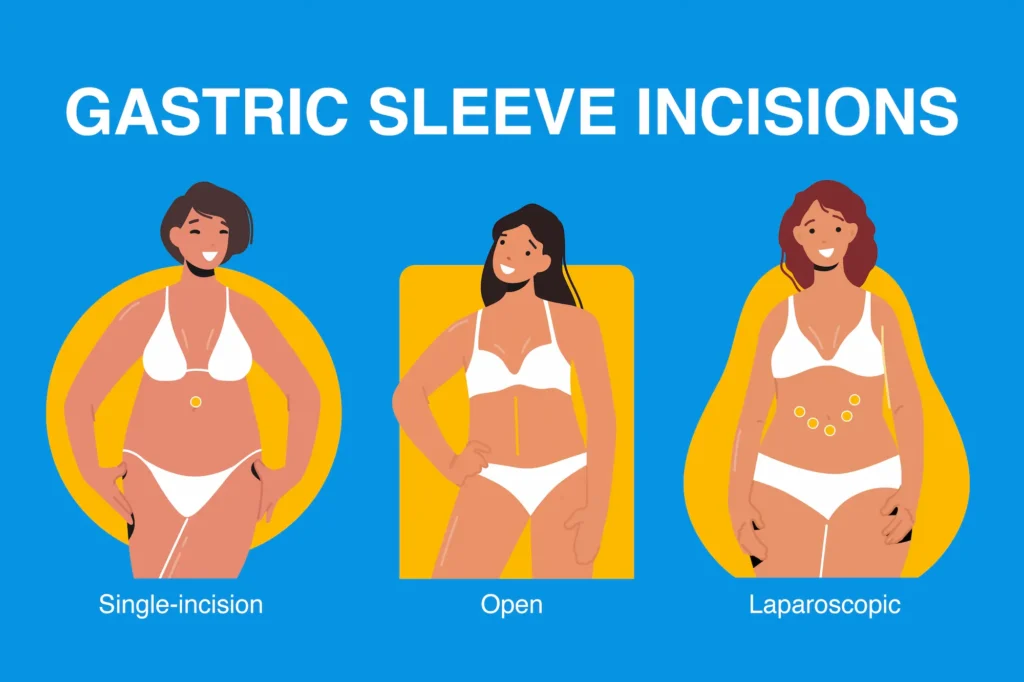What are Gastric Sleeve Incisions
Gastric sleeve surgery, a pivotal procedure in bariatric surgery, involves specific techniques for making incisions, which are integral to the success and safety of the operation. Gastric sleeve incisions are the surgical cuts made during a gastric sleeve procedure, a type of bariatric surgery aimed at aiding significant weight loss. This procedure is medically known as sleeve gastrectomy. Understanding these incisions, their healing process, and long-term care is essential for anyone considering this weight loss surgery.

Exploring the Different Types of Gastric Sleeve Incisions
In gastric sleeve surgery, the type of incision plays a crucial role in both the surgical process and the patient’s recovery. There are primarily three types of incisions utilized in these procedures: Laparoscopic, Single Incision, and Open. Each type has its distinct characteristics and implications.
Laparoscopic Incisions
Laparoscopic surgery is the most common approach for gastric sleeve procedures. It involves making 5-6 small incisions in the abdominal wall, between 5mm and 15mm in length.. These incisions are strategically placed to allow surgical instruments and a camera (laparoscope) access to the stomach. The benefits of this approach include:
- Minimized Scarring: Due to the small size of the incisions, laparoscopic surgery results in less visible scarring.
- Reduced Pain and Quicker Recovery: Patients typically experience less post-operative discomfort and a faster recovery period compared to open surgery.
- Lower Risk of Complications: There’s a reduced risk of complications like infections and hernias.
Single Site Incision Gastric Sleeve
In some instances, bariatric surgeons may opt for a single-incision gastric sleeve. This advanced technique involves making a single, slightly larger incision, typically hidden in the belly button, through which the entire procedure is performed robotically.
However, the single-incision technique may not be suitable for all patients and is typically reserved for those who meet specific criteria. It is performed robotically and would take slightly more time. There would typically be more pain associated with this type of approach.
Open Surgery Incisions
Though less common nowadays due to the advancement of minimally invasive techniques, open surgery is still utilized in certain cases. This traditional method involves making a large incision in the abdomen to access the stomach. While this approach is less favored, it might be necessary in certain complex cases or when laparoscopic surgery is not viable. The implications of open surgery include:
- Longer Recovery Period: Recovery from open surgery generally takes longer due to the larger incision.
- Increased Visibility of Scars: The scars from open surgery are more prominent compared to laparoscopic and single-incision techniques.
- Greater Risk of Post-Surgical Complications: There is a higher risk of complications such as infections and hernias with open surgery.
Each type of incision has its specific indications and potential benefits. The choice of incision type is based on various factors, including the patient’s medical history, body composition, and the surgeon’s expertise and preference. It’s crucial to discuss these options with your bariatric surgeon to determine the most appropriate approach for your gastric sleeve surgery.
The Healing Journey of Gastric Sleeve Incisions
The postoperative healing process is a critical phase. Gastric sleeve incision healing typically spans 2-4 weeks. During this period, patients must adhere to their surgeon’s guidelines on incision care. This includes keeping the incision sites clean, dry and well-protected to foster healing and prevent infection.
Effective Incision Care Post-Gastric Sleeve Surgery
Proper care of your incisions post-gastric sleeve surgery is paramount for preventing infections and ensuring smooth healing. Here’s a detailed guide on how to care for your incisions:
- Immediate Post-Surgery Care: Keep the incision area clean and dry. Gently cleaning the incision with mild soap and water is typically advised, avoiding soaking or scrubbing the area. Follow your surgeon’s instructions on dressing the wound, which might involve changing bandages or applying topical ointments.
- Activity and Incision Care: Avoid strenuous activities and heavy lifting for the recommended period to prevent strain on the incisions. Gradually reintroduce physical activities as advised by your healthcare provider. Generally speaking, there are no physical restrictions on someone after surgery
- Monitoring for Complications: Regularly inspect the incisions for signs of infection, such as increased redness, warmth, swelling, or unusual discharge. Report any concerns, like fever or worsening pain, to your surgeon immediately.
- Scar Management: Once the incisions are fully healed, consider using silicone gel or scar-reducing creams to minimize scarring, but only after consulting with your surgeon. Protect the scars from sun exposure as UV rays can darken them, prolonging the fading process.
- Follow-Up Appointments: Keep all scheduled follow-up appointments with your bariatric surgeon to ensure your incisions are healing as expected and to address any issues promptly.
By adhering to these guidelines, you can help ensure that your incisions heal properly, reducing the risk of complications and improving the overall outcome of your gastric sleeve surgery.
Recognizing and Addressing Potential Complications
While gastric sleeve surgery is generally safe, being aware of potential complications related to the incisions is important. These complications can include infections, hernias at the incision sites, and issues related to wound healing. In the event of any unusual symptoms, it’s imperative to consult with your bariatric surgeon immediately.
Long-Term Considerations of Gastric Sleeve Incisions
In the long term, the outlook for gastric sleeve incisions is positive, with most incisions healing to form minimal scarring. The appearance of gastric sleeve scars typically presents as small, thin lines on the abdomen. Scar appearance can vary based on individual factors like skin type and adherence to post-operative care instructions. Using recommended scar reduction treatments and following a healthy lifestyle can further improve the appearance of these scars.
Taking the Next Step with BMI
Gastric sleeve incisions are a crucial component of this transformative weight loss surgery. Understanding the types of incisions, their healing process and the importance of post-operative care is key to a successful recovery and long-term results. At BMI of Texas, our team of skilled bariatric surgeons and healthcare professionals is dedicated to providing you with comprehensive care and support throughout your weight loss journey.
If you’re considering gastric sleeve surgery and have questions about the procedure, including the incisions and their long-term care, reach out to BMI for expert guidance. We’re here to help you make informed decisions and embark on a path to a healthier, more fulfilling life. Contact us today to schedule a consultation and take the first step towards achieving your weight loss goals with BMI’s support.
You might also be interested in: Gastric sleeve vs gastric balloon

